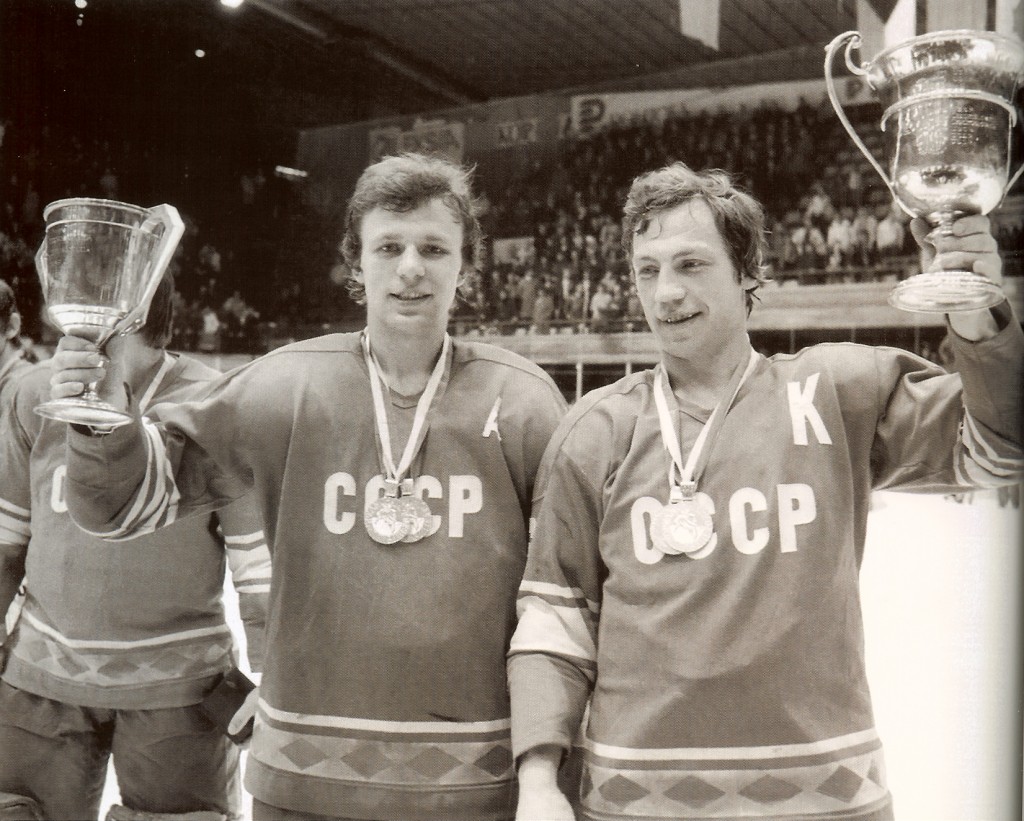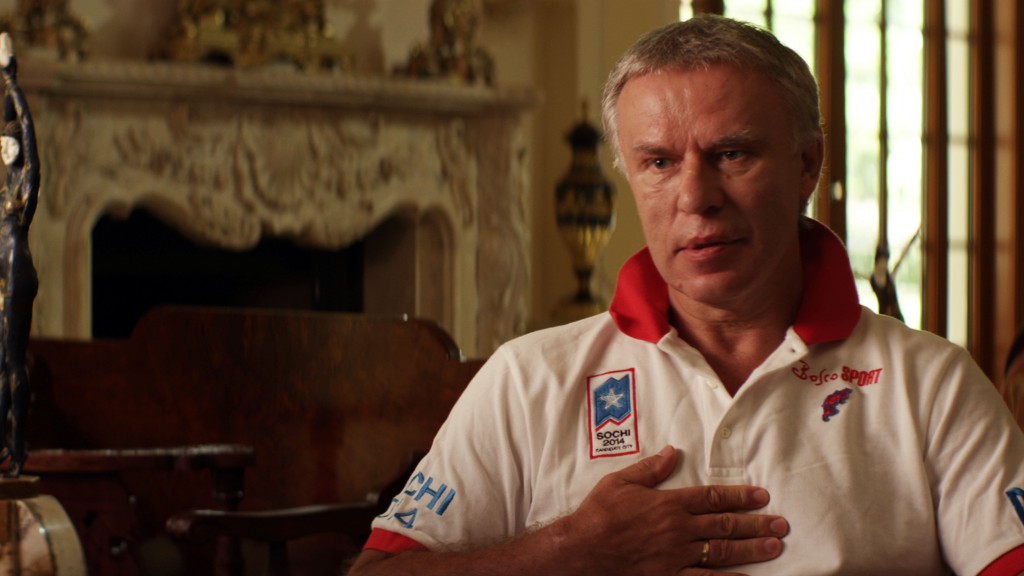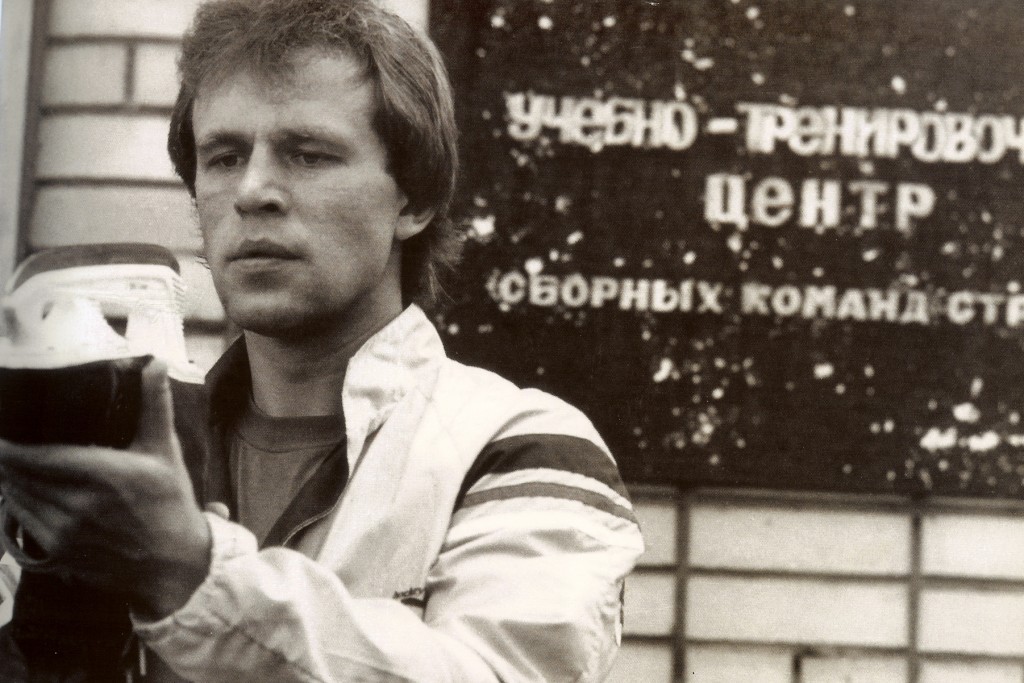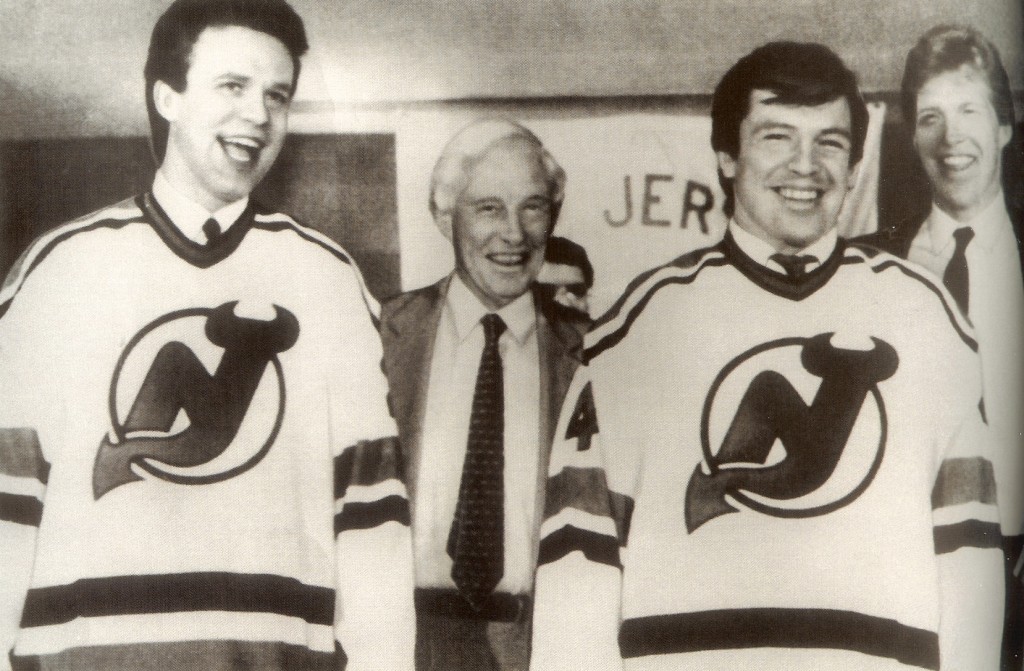Everyone knows the story of the “Miracle on Ice,” the United States stunning victory over the Soviet juggernaut of a hockey team during the 1980 Winter Olympics in Lake Placid, whether you witnessed it or have relived the Disney-fied version.
The Soviets were/are an easy target during the Cold War; Coach Viktor Tikhonov was like a movie villain that had materialized in real life.He was very much the same thing to his players, one of many things Gabe Polsky’s documentary Red Army seeks to enlighten us about the team that was on the other side of history, and widely acknowledged as one of the greatest hockey teams ever.
While Red Army passes the puck to other members of the Russian Five, including fellow defenseman Alexei Kasatonov, Vladimir Krutov (“The Tank”) as well as their legendary goalie, Vladislav Tretiak, the story mostly unfolds under the purview of their fascinating Captain and defenseman, Vyacheslav Fetisov, or Slava.
We learn his story, a story that is inextricably linked to the major events of the Cold War, because hockey was the Soviet Union, a propagandistic weapon that sought to prove Soviet supremacy. Sports wasn’t just an extension of war, it was a battleground. Despite squeezing three families into a 400 square foot apartment without power, Slava had a happy childhood because he got to play hockey, his parents scraping together the money for the necessary equipment over several years, leading to a tryout for the Red Army, the Soviet Union’s national team.
Red Army combines incredible archival footage of these tryouts and early practices, with insightful video featuring the coaching and tutelage of Anatoly Tarasov, the father of the Soviet’s hockey system, imbuing a brutal sport with grace, shaping the improvisational and artful style of the CCCP.
Unfortunately (and obviously), Tikhonov refused to be interviewed for this film, but it’s clear that when the KGB Chief’s protégé replaced Tarasov as coach of the Red Army, it changed everything. It’s fair to wonder if the Soviets would’ve ever lost in 1980 with Tarasov at the helm, and who knows how that would’ve rearranged the alternate history dominoes in the Cold War; there’s a compelling “What If?” story here, one that I wish Red Army had tackled head on. Everyone respected Tikhonov as their coach because they had to; but Slava was clear, he didn’t respect the man as a person.
After their loss, Tikhonov fired veterans of the team, while the remaining players, including Slava, were forced to practice four times a day, stuck in a hockey compound 11 months out of the year, only allowed outside one weekend a month. Their sons didn’t recognize their fathers when they returned home. And even so, Slava (and others) never thought of defecting from his country. Instead, he quit the team, a move that was met by support from three of the Russian Five, with the noted exception of his best friend Alexei, something Slava still can’t understand or come to grips with.
In many ways, Red Army is a heroic portrait of Slava. This is a man used by his country, yet remained loyal to it. Despite public insistences by the USSR that Slava could go to the NHL, they privately told him he couldn’t. So he quit the national team. His family was constantly followed around by KGB agents; at one point he was handcuffed to a car battery and beaten up; this is a man who helped bring gold medals to the country in ’84 and ‘88. Slava refused to sell his services to the U.S. at a fraction of what he was worth, as his government demanded 50-90% of his salaries. Every one of his peers took the deal, but Slava remained resolute, alone, training with a hermetic Anatoly Tarasov in a very Rocky IV-like remote bunker,until he garnered the first visa to the U.S. after standing up to the Minister of Defense, the second most powerful man in the Soviet Union. After a tough but ultimately heroic career in the NHL with the New Jersey Devils and the Detroit Red Wings, Slava is the Minister of Sport in his country, working to right the wrongs of the past.
Red Army covers an astonishing amount of ground (ice?) in just 85 minutes, focusing on the events from 1978-1985, but covering Slava’s life from 1958 to the present, touching upon the major historic plot points along the way. There’s a playful, sarcastic banter between Slava and Gabe; the movie opens with Slava flipping Gabe off while he’s on the phone. He’s busy; he works 20 hour days, something Americans wouldn’t understand, because they “don’t do anything.” Despite his oftentimes combative and guarded personality, he’s by far the most personable person Polsky interviews, with the exception of a wry retired KGB agent (
Everyone knows the story of the “Miracle on Ice,” the United States stunning victory over the Soviet juggernaut of a hockey team during the 1980 Winter Olympics in Lake Placid, whether you witnessed it or have relived the Disney-fied version.
The Soviets were/are an easy target during the Cold War; Coach Viktor Tikhonov was like a movie villain that had materialized in real life.He was very much the same thing to his players, one of many things Gabe Polsky’s documentary Red Army seeks to enlighten us about the team that was on the other side of history, and widely acknowledged as one of the greatest hockey teams ever.
While Red Army passes the puck to other members of the Russian Five, including fellow defenseman Alexei Kasatonov, Vladimir Krutov (“The Tank”) as well as their legendary goalie, Vladislav Tretiak, the story mostly unfolds under the purview of their fascinating Captain and defenseman, Vyacheslav Fetisov, or Slava.
We learn his story, a story that is inextricably linked to the major events of the Cold War, because hockey was the Soviet Union, a propagandistic weapon that sought to prove Soviet supremacy. Sports wasn’t just an extension of war, it was a battleground. Despite squeezing three families into a 400 square foot apartment without power, Slava had a happy childhood because he got to play hockey, his parents scraping together the money for the necessary equipment over several years, leading to a tryout for the Red Army, the Soviet Union’s national team.
Red Army combines incredible archival footage of these tryouts and early practices, with insightful video featuring the coaching and tutelage of Anatoly Tarasov, the father of the Soviet’s hockey system, imbuing a brutal sport with grace, shaping the improvisational and artful style of the CCCP.
Unfortunately (and obviously), Tikhonov refused to be interviewed for this film, but it’s clear that when the KGB Chief’s protégé replaced Tarasov as coach of the Red Army, it changed everything. It’s fair to wonder if the Soviets would’ve ever lost in 1980 with Tarasov at the helm, and who knows how that would’ve rearranged the alternate history dominoes in the Cold War; there’s a compelling “What If?” story here, one that I wish Red Army had tackled head on. Everyone respected Tikhonov as their coach because they had to; but Slava was clear, he didn’t respect the man as a person.
After their loss, Tikhonov fired veterans of the team, while the remaining players, including Slava, were forced to practice four times a day, stuck in a hockey compound 11 months out of the year, only allowed outside one weekend a month. Their sons didn’t recognize their fathers when they returned home. And even so, Slava (and others) never thought of defecting from his country. Instead, he quit the team, a move that was met by support from three of the Russian Five, with the noted exception of his best friend Alexei, something Slava still can’t understand or come to grips with.
In many ways, Red Army is a heroic portrait of Slava. This is a man used by his country, yet remained loyal to it. Despite public insistences by the USSR that Slava could go to the NHL, they privately told him he couldn’t. So he quit the national team. His family was constantly followed around by KGB agents; at one point he was handcuffed to a car battery and beaten up; this is a man who helped bring gold medals to the country in ’84 and ‘88. Slava refused to sell his services to the U.S. at a fraction of what he was worth, as his government demanded 50-90% of his salaries. Every one of his peers took the deal, but Slava remained resolute, alone, training with a hermetic Anatoly Tarasov in a very Rocky IV-like remote bunker,until he garnered the first visa to the U.S. after standing up to the Minister of Defense, the second most powerful man in the Soviet Union. After a tough but ultimately heroic career in the NHL with the New Jersey Devils and the Detroit Red Wings, Slava is the Minister of Sport in his country, working to right the wrongs of the past.
Red Army covers an astonishing amount of ground (ice?) in just 85 minutes, focusing on the events from 1978-1985, but covering Slava’s life from 1958 to the present, touching upon the major historic plot points along the way. There’s a playful, sarcastic banter between Slava and Gabe; the movie opens with Slava flipping Gabe off while he’s on the phone. He’s busy; he works 20 hour days, something Americans wouldn’t understand, because they “don’t do anything.” Despite his oftentimes combative and guarded personality, he’s by far the most personable person Polsky interviews, with the exception of a wry retired KGB agent (Felix Nechepore). Everyone else is unwilling to elaborate, or to explore their relationships. Alexei refuses to discuss what happened with Slava, telling the camera it’s not the time. You can’t help but respect that (I wouldn’t try to mend bridges during a documentary either), but as a viewer, you can’t help but want more. But that’s kind of the point. When Gabe asks each of the Red Army players about each other, their tics, their personalities, they’re hobbies, they respond: “We’re the same.” We don’t believe it, but they do, remnants of the Soviet system still coloring their commentary.
While it certainly won’t have you rooting for the Red Army the next time you pop in Miracle (unless you’re Barney Stinson), it will give you second thoughts. Red Army humanizes and informs us of the struggles that these incredible athletes had to go through, but stops short of giving us the kind of answers or peace of mind we want, because there isn’t any to be had. There’s been a veil of secrecy over Russia for so long, that even when truths are revealed, you can’t help but think there’s that much more to tell.
). Everyone else is unwilling to elaborate, or to explore their relationships. Alexei refuses to discuss what happened with Slava, telling the camera it’s not the time. You can’t help but respect that (I wouldn’t try to mend bridges during a documentary either), but as a viewer, you can’t help but want more. But that’s kind of the point. When Gabe asks each of the Red Army players about each other, their tics, their personalities, they’re hobbies, they respond: “We’re the same.” We don’t believe it, but they do, remnants of the Soviet system still coloring their commentary.
While it certainly won’t have you rooting for the Red Army the next time you pop in Miracle (unless you’re Barney Stinson), it will give you second thoughts. Red Army humanizes and informs us of the struggles that these incredible athletes had to go through, but stops short of giving us the kind of answers or peace of mind we want, because there isn’t any to be had. There’s been a veil of secrecy over Russia for so long, that even when truths are revealed, you can’t help but think there’s that much more to tell.
RED ARMY opens New York and LA this Friday, January 23rd, 2015.






